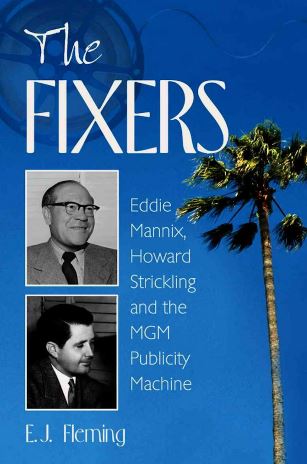By Miriam Cleeman
Who do you call when you’re in trouble? Your mother? Your spouse? For someone in the public eye, it’s probably a publicist, a person whose job was created as celebrity created celebrities. Suddenly there was an entire class of people whose lives were opened to the public. With the growth and globalization of film at the beginning of the twentieth century came a faster means of publicizing one’s face and name. But while one’s public image now became a chief concern, it was their owners, per se, not the celebrities themselves who worried most. The studio system, the cornerstone of the Hollywood framework from its birth through the 1950’s, contracted actors, writers, and directors to a single studio, requiring them to play whatever role the studio saw fit or be loaned out for other projects.
 MGM, one of the original Hollywood studios, was also one of the first to develop their own insurance policy to protect their stars from public ridicule, in the form of Eddie Mannix and Howard Strickling. These two men, the “fixers” – and the subjects of E.J. Flemming’s book of the same name – are barely known even to movie buffs but they were behind the “handling” of some of the greatest scandals Hollywood has ever seen.
MGM, one of the original Hollywood studios, was also one of the first to develop their own insurance policy to protect their stars from public ridicule, in the form of Eddie Mannix and Howard Strickling. These two men, the “fixers” – and the subjects of E.J. Flemming’s book of the same name – are barely known even to movie buffs but they were behind the “handling” of some of the greatest scandals Hollywood has ever seen.
Clark Gable and Loretta Young
In 1935, Loretta Young was 23 and already a Hollywood veteran, beginning her third decade in the industry. She was also, rather notably, a devout Roman Catholic. This might not have ever really played into her narrative had she not met Clark Gable, Hollywood’s quintessential – and married – playboy. Gable set his sights on the seemingly unattainable Young during shooting of MGM’s CALL OF THE WILD. A few months after shooting wrapped, Young invited Gable to her Sunset Boulevard home where she informed him that she was pregnant. Gable called Strickling.
Unlike other such cases, Strickling knew that the usual cover up – an abortion performed in a hotel room or under an pseudonym – was out of the question for Young. Strickling organized a European trip for Young and her mother, but confounded the press when she seemingly disappeared in England. In reality, she was secreted back to Venice Beach, where she gave birth to a daughter in November of 1935, overseen by studio doctors and nurses.
As rumors began to spread about Young’s disappearance, Strickling flooded the press with stories of her mysterious illness, even facilitating an in-home interview, Young lying in bed connected to a dummy-IV. She gradually, of course, recovered and went back to work.
Almost two years later, to divert attention from another damaging MGM scandal, Strickling announced that Loretta Young was adopting two little girls: Jane, age 3, and Judy, 23-1/2 months. Two girls, to avoid the suspicion that might have arisen if Young had simply adopted a single girl out of nowhere. Shortly after, it was announced that Jane’s mother had wanted her daughter back and a heartbroken Young publicly relinquished her.
Strickling had successfully preserved Young’s image and allowed her to raise her daughter with only one lasting repercussion. Judy was never to be photographed in public without a hat. She had Gable’s ears.
The Rise and Fall of Judy Garland
More invasive and expansive than in Loretta Young’s case was MGM’s involvement in the life of Judy Garland. Signed to MGM when she was just 13, Garland was confined to younger roles in her first decade at the studio in which she came to public attention with the Andy Hardy series and, of course, THE WIZARD OF OZ (1939).
But while she experienced early popularity, this came with an extreme price for her and many of her young co-stars: MGM wanted to capitalize on their popularity and ramp up the number of films they made. It became common place to prescribe amphetamines to increase a star’s productivity and barbiturates to counteract the amphetamines so they could sleep. While many developed drug addictions, Garland’s swelled to emotional dependencies, sexual affairs, and depression leading to multiple suicide attempts.
At each incident, setback, and relapse, Mannix and Strickling played a role: they orchestrated relationships and friendships for Garland. They arranged rehabs, as well as additional drugs. And finally, after years of abuse towards one of their highest grossing stars, they fired her. Although she would live another sixteen years, this was the beginning of her end.
It’s easy to paint Mannix and Strickling as amoral conspirators or valiant protectors. Far more important to their story and that of Hollywood’s formative years is the influence that they managed to wield. They could sway both the mob and the police. They could cover up murders, affairs, abortions, addictions, and careers. The Fixers: Eddie Mannix, Howard Strickling, and the MGM Publicity Machine (2005) tells so many of these sordid and unfathomable stories, and sheds a light on an otherwise forgotten cornerstone of Hollywood history.
Miriam Cleeman works in film and video production at Crystal City Entertainment in Silver Spring, Maryland, and Sparks Next in Brooklyn, New York.

















